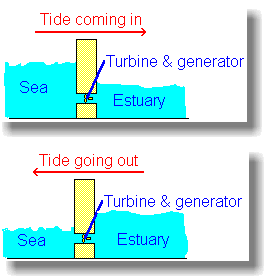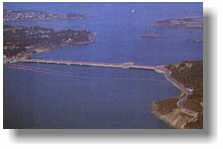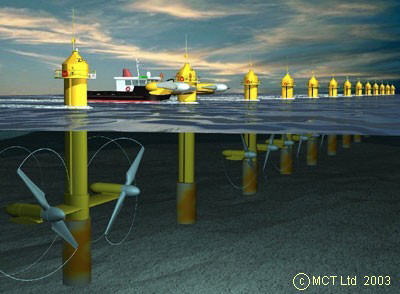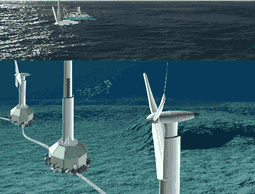![]()
![]()
![]()
![]()
![]()
![]()
![]()
![]()
![]()
![]()
![]()
This site is designed to be viewed on an
800 x 600 screen,
with level 4+ browsers.
Created by Andy Darvill,
Science teacher at
Broadoak Community School,
Weston-super-Mare, England
Web site www.darvill.clara.net
Introduction How it works More details Advantages Disadvantages Is it renewable?
![]()
Introduction
|
The tide moves a huge amount of water twice each day, and harnessing it could provide a great deal of energy - around 20% of Britain's needs. Although the energy supply is reliable and plentiful, converting it into useful electrical power is not easy. There are eight main sites around Britain where tidal power stations could usefully be built, including the Severn, Dee, Solway and Humber estuaries. Only around 20 sites in the world have been identified as possible tidal power stations. |
 |
![]()
How it works: Tidal Barrages
|
These work rather like a hydro-electric scheme, except that the dam is much bigger. A huge dam (called a "barrage") is built across a river estuary. When the tide goes in and out, the water flows through tunnels in the dam. The ebb and flow of the tides can be used to turn a turbine, or it can be used to push air through a pipe, which then turns a turbine. Large lock gates, like the ones used on canals, allow ships to pass. If one was built across the Severn Estuary, the tides at Weston-super-Mare would not go out nearly as far - there'd be water to play in for most of the time. But the Severn Estuary carries sewage and other wastes from many places (e.g. Bristol & Gloucester) out to sea. A tidal barrage would mean that this stuff would hang around Weston-super-Mare an awful lot longer! Also, if you're a wading bird that feeds on the exposed mud flats when the tide goes out, then you have a problem, because the tide won't be going out properly any more. |
 |
![]()
More details
|
The largest tidal power station in the world (and the only one in Europe) is in the Rance estuary in northern France. It was built in 1966. A major drawback of tidal power stations is that they can only generate when the tide is flowing in or out - in other words, only for 10 hours each day. However, tides are totally predictable, so we can plan to have other power stations generating at those times when the tidal station is out of action. |

|
There have been plans for a "Severn Barrage" from Brean Down in Somerset to Lavernock Point in Wales. Every now and again the idea gets proposed, but nothing has been built yet.
It may have over 200 large turbines, and provide over 8,000 Megawatts of power (that's over 12 nuclear power station's worth). It would take 7 years to build, and could provide 7% of the energy needs for England and Wales.
There would be a number of benefits, including protecting a large stretch of coastline against damage from high storm tides, and providing a ready-made road bridge. However, the drastic changes to the currents in the estuary could have huge effects on the ecosystem.
![]()
|
Another option
is to use This has the advantage of being much cheaper to build, and does not have the environmental problems that a tidal barrage would bring. There are also many more suitable sites. Find out more about the world's first offshore tidal power station at www.marineturbines.com/technical.htm |
 |
  |
The University of Wales Swansea and partners are also researching techniques to extract electrical energy from flowing water. The "Swanturbines" design is different to other devices in a number of ways. The most significant is that it is direct drive, where the blades are connected directly to the electrical generator without a gearbox between. This is more efficient and there is no gearbox to go wrong. Another difference is that it uses a "gravity base", a large concrete block to hold it to the seabed, rather than drilling into the seabed. Finally, the blades are fixed pitch, rather than actively controlled, this is again to design out components that could be unreliable. Find out more at www.swanturbines.co.uk |
|
Yet
another option: Find out more from the Canadian company Blue Energy at www.bluenergy.com |
Advantages
- Once you've
built it, tidal power is free.
- It produces
no greenhouse gases or other waste.
- It needs no
fuel.
- It produces
electricity reliably.
- Not expensive
to maintain.
- Tides are totally
predictable.
- Offshore turbines and vertical-axis turbines are not ruinously expensive to build and do not have a large environmental impact.
![]()
Disadvantages
- A barrage across
an estuary is very expensive to build, and affects a very wide area
- the environment is changed for many miles upstream and downstream.
Many birds rely on the tide uncovering the mud flats so that they
can feed. There are few suitable sites for tidal barrages.
- Only provides
power for around 10 hours each day, when the tide is actually moving
in or out.
![]()
Is it renewable?
Tidal energy is renewable. The tides will continue to ebb and flow, and the energy is there for the taking.
![]()
|
|
|
Want
to discuss alternative energy issues? by James Wilson |